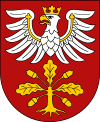Dąbrowa Tarnowska
| Dąbrowa Tarnowska | ||
|---|---|---|
|
Town Hall | ||
| ||
 Dąbrowa Tarnowska | ||
| Coordinates: 50°10′N 20°59′E / 50.167°N 20.983°E | ||
| Country |
| |
| Voivodeship | Lesser Poland | |
| County | Dąbrowa | |
| Gmina | Dąbrowa Tarnowska | |
| Established | 16th century | |
| Town rights | 1693 | |
| Government | ||
| • Mayor | Stanisław Początek | |
| Area | ||
| • Total | 23.07 km2 (8.91 sq mi) | |
| Elevation | 120 m (390 ft) | |
| Population (2007) | ||
| • Total | 11,720 | |
| • Density | 510/km2 (1,300/sq mi) | |
| Time zone | CET (UTC+1) | |
| • Summer (DST) | CEST (UTC+2) | |
| Postal code | 33-200 | |
| Area code(s) | +48 14 | |
| Car plates | KDA | |
| Website | http://www.dabrowatar.pl/. | |
Dąbrowa Tarnowska [dɔmˈbrɔva tarˈnɔfska] is a town in Poland, in Lesser Poland Voivodeship, about 16 kilometres (10 mi) north of Tarnów. It is the capital of Dąbrowa County. Before reorganization (in 1999) Dąbrowa Tarnowska was part of Tarnów Voivodeship (1975–1998). Population is 11,402 (2008). Dąbrowa Tarnowska has a rail station on the minor line which joins Tarnów and Szczucin.
Geography
Dąbrowa lies on the Bren river, on the boundary of two geographic regions, the Carpathian Foothills and the Sandomierz Basin. The town is a home to a football club Dabrovia Dąbrowa Tarnowska (established in 1922), which plays in the regional league, the sixth level of Polish football league system. Furthermore, Dąbrowa has ruins of a Baroque palace of the Lubomirski family, as well as a 19th-century synagogue. The name of the town comes from oak groves, called dąbrowy in Polish, which were abundant here in the past. Dąbrowa used to be called Dambrawa Wielka (Dambrawa Magna) as well as Dobrowa, and finally the adjective “Tarnowska” was added to it, to distinguish it from Dąbrowa Górnicza and Dąbrowa Białostocka.
History
Dąbrowa Tarnowska was first mentioned as a parish village in 1326. At that time, it already was a large village, which belonged to the noble Ligeza family, and had a mill, fish farm, 60 agricultural farms and a folwark. In 1614, a new parish church was built by Mikolaj Ligeza who in the 1630s also built a defensive palace (palazzo in fortezza), protected by the Bagienica river. The palace was square shaped, with a rampart and four bastions. In 1683-1693, Michal Lubomirski built a new, Baroque palace, and as a result, the old palace ceased to be a family residence, and was turned into a brewery. In the Kingdom of Poland and the Polish-Lithuanian Commonwealth, Dąbrowa belonged to the Sandomierz Voivodeship.
Dąbrowa Tarnowska was granted town charter probably in 1693, and the town was developed east of the Lubomirski palace. In 1771, a new, large church was built, and following the first partition of Poland (see Partitions of Poland), the town became part of Austrian Galicia, where it remained from 1772 until 1918. In 1846, the Lubomirski palace burned in a fire, after which it was never rebuilt. A post-office named DOMBROWA was opened in 1858.[1] The town was part of the Austria side after the compromise of 1867, head of the DABROWA district, one of the 78 Bezirkshauptmannschaften in Austrian Galicia province (Crown land).[2]
In 1948-1965, a church was built in the location of the palace, all that remains of the complex is its main gate. In 1906, the rail line from Tarnów to Szczucin was opened, and in the Second Polish Republic, Dąbrowa was part of the Kraków Voivodeship.
References
Sources
External links
| Wikimedia Commons has media related to Dąbrowa Tarnowska. |
- Official town webpage
- Jewish Community in Dąbrowa Tarnowska on Virtual Shtetl
Coordinates: 50°10′N 20°59′E / 50.167°N 20.983°E


